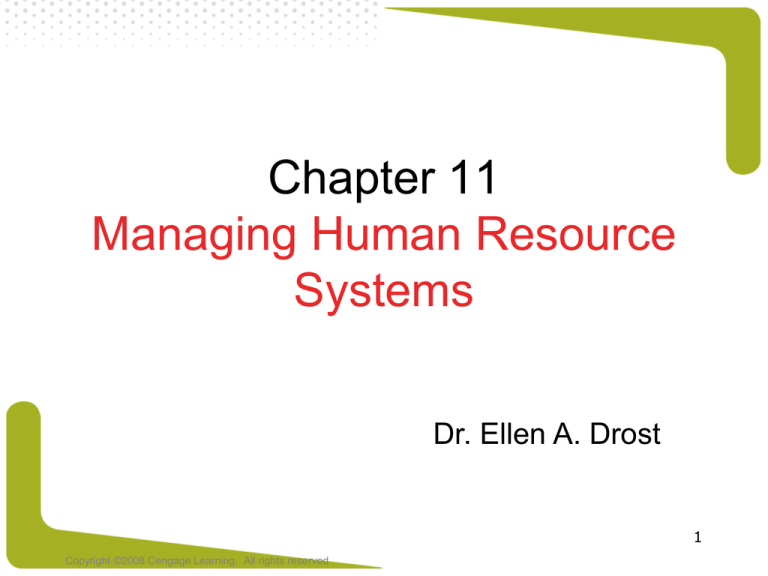
Chapter 11
Managing Human Resource
Systems
Dr. Ellen A. Drost
1
Copyright ©2008 Cengage Learning. All rights reserved
The Human Resource Management Process
Attracting Qualified
Employees
Developing Qualified
Employees
Recruiting
Selection
Training
Performance Appraisal
Keeping Qualified
Employees
Compensation
Employee Separation
2
Copyright ©2008 Cengage Learning. All rights reserved
Beyond the Book
Human Resource Planning
Supply and Demand
of
Human Resources
Human Resource
Information
Systems
Internal and External
3
Copyright ©2008 Cengage Learning. All rights reserved
Beyond the Book
Internal Forecast Factors
New positions
New equipment and
technology
Eliminated positions
Terminations
Turnover
Deaths
Promotions
Organization’s mission
Productivity of current
employees
Skills/education of
current employees
Retirements
Resignations
Transfers
4
Copyright ©2008 Cengage Learning. All rights reserved
Beyond the Book
External Forecast Factors
•
Demographics of
labor supply
Unemployment rate
•
Labor unions
Geographic
population shifts
•
Availability of
applicants
Manufacturing-to
service-to
information-based
economy shift
Technological
advances
Competitors
Growth of businesses
•
Economic conditions
5
Copyright ©2008 Cengage Learning. All rights reserved
HRM Process: Recruiting
Job Analysis
and
Recruiting
Internal
Recruiting
External
Recruiting
2
6
Copyright ©2008 Cengage Learning. All rights reserved
Job Analysis and Recruiting
Recruiting
Selection
Training
Performance
Separation
Appraisal
HR Subsystems
Job Description
tasks, duties, responsibilities
2.1
Job Specification
qualifications, skills.
Job Analysis
information on work-related
aspects of the job
Copyright ©2008 Cengage Learning. All rights reserved
7
Internal Recruiting
2.2
• A pool of applicants who already
work for the company
• “Promotion from within”
• Improves employee morale and
motivation
• Reduces employer time and cost
• Job posting is the procedure for
internal advertising
• Career path is a planned
sequence of jobs
8
Copyright ©2008 Cengage Learning. All rights reserved
Methods for External
Recruiting
•
•
•
•
•
•
•
Advertising
Employee referrals
Walk-ins
Outside organizations
Employment services
Special events
Internet job sites
2.3
9
Copyright ©2008 Cengage Learning. All rights reserved
HRM PROCESS: Selection
Application Forms
and Résumés
References and
Background Checks
Selection
Tests
Interviews
3
10
Copyright ©2008 Cengage Learning. All rights reserved
References and Background Checks
• References or background checks are not always
provided by previous employers
• Making background checks more effective
–
–
–
–
dig deeper for more information
get permission in writing
document all checks
consider hiring private investigators
11
Copyright ©2008 Cengage Learning. All rights reserved
Selection Tests
Specific
Ability
Assessment
Centers
Cognitive
Ability
Selection
Tests
Biographical
Data
Work
Sample
Personality
3.3
12
Copyright ©2008 Cengage Learning. All rights reserved
Interviews
• Unstructured Interviews
– free-flow of questions
• Structured Interviews
– interviewer uses standard set of prepared
questions
• Semi-structured Interviews
3.4
– some structure combined with interviewer
judgement
13
Copyright ©2008 Cengage Learning. All rights reserved
Topics Employers Should Avoid
1. Children
2. Age
3. Disabilities
4. Physical Characteristics
5. Name
6. Citizenship
7. Lawsuits
8. Arrest records
9. Smoking
10. AIDS/HIV
3.1
14
Copyright ©2008 Cengage Learning. All rights reserved
Questions in Structured Interviews
Situational Questions
Behavioral Questions
Background Questions
Job-Knowledge Questions
3.4
15
Copyright ©2008 Cengage Learning. All rights reserved
HRM PROCESS: Training
Training
Needs
Training
Methods
Training
Evaluation
4
16
Copyright ©2008 Cengage Learning. All rights reserved
Determining Training Needs
Identify
Performance
Deficiencies
Listen to
Customer
Complaints
Conducting
Needs
Assessments
Survey
Employers
and Managers
Test Employee
Skills and
Knowledge
4.1
17
Copyright ©2008 Cengage Learning. All rights reserved
Training Methods
Impart Information
and Knowledge
• films and videos
• lecture
• planned readings
Develop Analytical
and Problem-Solving
Skills
• case studies
• coaching and mentoring
• group discussions
Practice, Learn, or
Change Job
Behaviors
•
•
•
•
All of the above
• Computer-based learning
on-the-job training
role-playing
simulations and games
vestibule training
4.2
18
Copyright ©2008 Cengage Learning. All rights reserved
Evaluating Training
Reactions
how satisfied trainees were
with the program
Learning
how much employees improved
their knowledge or skills
Behavior
how much employees actually changed
their on-the-job behavior
Results
how much training improved
job performance
4.3
19
Copyright ©2008 Cengage Learning. All rights reserved
HRM PROCESS:
Performance Appraisal
Measuring
Job
Performance
5
20
Copyright ©2008 Cengage Learning. All rights reserved
Measuring Job Performance:
Common Rating Errors
• Central tendency
– all workers are rated as being “average”
• Halo error
– all workers are rated as performing at
the same level in all parts of their jobs
• Leniency error
– all workers are rated as performing at a
high level
5.1
21
Copyright ©2008 Cengage Learning. All rights reserved
Performance
Appraisal Measures
• Objective performance measures
– quantifiable outcomes (output, scrap, waste, sales,
customer complaints, or rejection rates)
• Subjective performance measures
– trait rating scales
– behavioral observation scales (BOS)
5.1
22
Copyright ©2008 Cengage Learning. All rights reserved
Subjective Performance Appraisal Scales
5.1
23
Copyright ©2008 Cengage Learning. All rights reserved
HRM PROCESS:
Compensation
Compensation
Decisions
Employment
Benefits
6
24
Copyright ©2008 Cengage Learning. All rights reserved
Pay-Level Decisions
• Job evaluation is used to determine the worth of jobs
– pay the “going rate”
• Should workers be paid at, below, or above current
market wage?
– attracts a larger, more qualified pool of applicants
– increases the rate of job acceptance
– decreases the time it takes to fill positions
– increases the time that employees stay
6.1
25
Copyright ©2008 Cengage Learning. All rights reserved
Pay-Structure Decisions
Hierarchical pay structures
big differences from one pay level to another
work best for independent work
Compressed pay structures
fewer pay levels with smaller differences in pay
between pay levels
work best for interdependent work
6.1
26
Copyright ©2008 Cengage Learning. All rights reserved
Beyond the Book
Employment Benefits
• Compensation other than direct wages
• Employee benefits are legally mandated:
– Social Security
– worker’s compensation
– unemployment insurance
• Cafeteria benefit plans
– employees can select from optional benefits
• Payroll deductions
27
Copyright ©2008 Cengage Learning. All rights reserved





